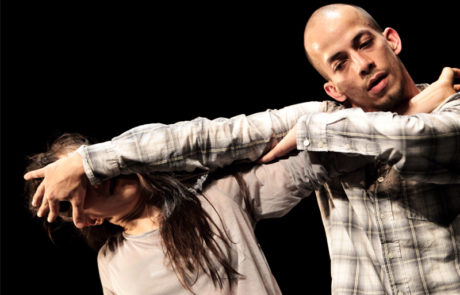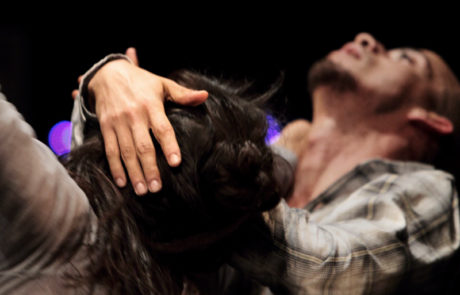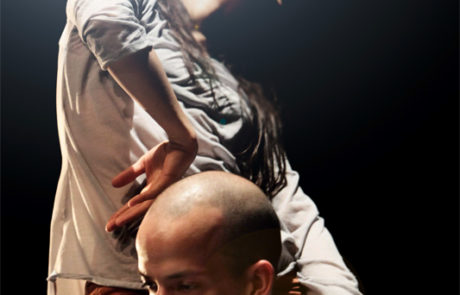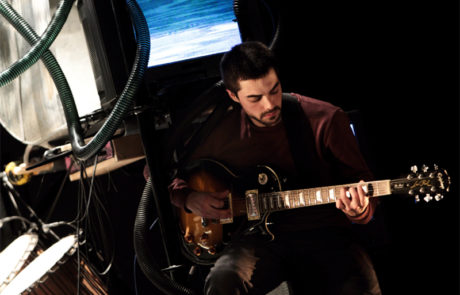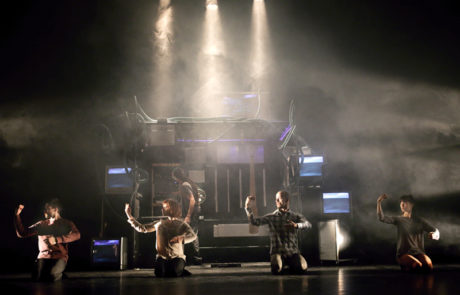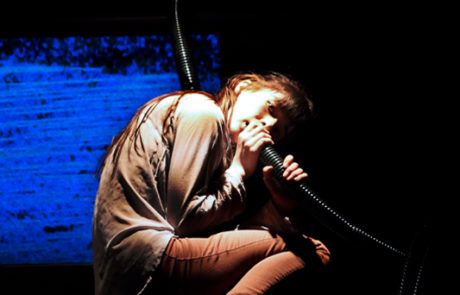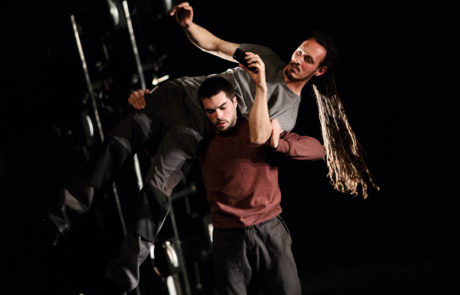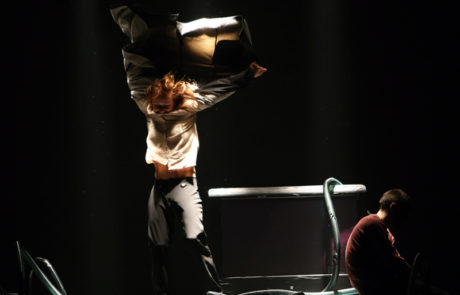A world that would absolutely exceed our power of understanding, the capacity of our imagination and our emotions, as well as our responsibility.
Günther Anders, Outdateness of humankind.
The piece deals with the relationship between people and their environment. Naturally this depends on both the people and their environment but other much more complex factors also play a part. This is because of the continuous and seemingly never-ending changes in society which have occurred over the past years… Our world changes without halt and in it mankind plays a new role, that of the “genial creator”. He shapes the landscape according to his wishes and has actually revolutionized nearly all aspects of life.
These changes go hand-in-hand with the necessity to permanently adapt himself. In order to comprehend and grasp the world around himself he searches for the essence of things. He tries to understand the complexity of the new and ever evolving “system” and at the same time remain unchanged. This cannot succeed. As what Günther Anders calls an “illegitimate son” he cannot transform and improve himself in the same way as his “products”. He longs to be freer, faster and more intelligent and would like to recreate himself every day, become more flexible and adaptable. At the same time he knows that his being and his soul just like his body cannot be newly formed like the things and objects, which have been created around him.
Mankind would gladly be new and original capable of developing his own way of thought and ability to reflect but as Anders puts it, the “background-noise” which rushes through/permeates our society holds him back. Against his will he gets “fed” with countless information, much of it useless which overtax his mind. The same applies to many conversations, which are conducted around him. All these images and ideas rotate endlessly in him but without being really understood.
The question is what difference exists between this “picture” of the world and reality. How much is only illusion? One could say that we are trained and conditioned to consume indiscriminately and without question everything that is presented to us. The problem is that this “veil” conceals what is really important. In this way the beauty as well as the tragedy inherent in life becomes relevated and often barely perceivable. A theme that carries through the entire piece is pressure, something that we are a victim of without even being really aware that it exists.
Human beings have a far greater potential for destruction than we can even imagine. How after all can he imagine this in view of his apparent insignificance compared with the negative power, which he has. The imbalance between life and the forces of destruction is immense. In the course of time it has become impossible for mankind to comprehend or imagine what chaos he himself can generate.
In spite of his threatening side he can be gentle and even loveable. This is when he allows himself moments of peace and relaxation. Foe the duration of a sigh we are pacified and fascinated. Is this only an illusion or is it because of the physical closeness and intimacy of the moment that we feel safe? However this feeling of content and wellbeing is often not enough. A new desire is aroused, the wish to know more possess, more command, more. Things that only yesterday were unknown to us become needs of today.
The way people relate and interact is very complex. It involves a multitude of different behaviour patterns, which change with each contact. Our relationship with our environment is just as complicated and fraught with contradictions. What do we comprehend and really absorb of the world we live in? How do we behave confronted by the never-ending masses of images and sounds that are crashing in on us? Are we aware what it means to live on the earth today? Are we still capable of perceiving, understanding, interpreting and feeling?
Matthias Kass (choreographer)
Clément Bugnon (choreographer)
Marylène Rouiller (acting coach)
Pierrick Grobéty (composer)
Besim Morina (light & stage-design)
Fhunyue Gao, Jolanda Löllman, Pierrick Grobéty, David Valencia & Matthias Kass (dancers)
Ida Zenna (photographer)
Issey Llambias (video)
Co-production: Théâtre Benno Besson
Support: Canton of Vaud, the cities of Yverdon-les-Bains and Sainte-Croix, LeZartiCirque, Ernst Gönner Foundation and the Migros Cultural Percent





